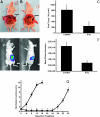Development of a novel preclinical pancreatic cancer research model: bioluminescence image-guided focal irradiation and tumor monitoring of orthotopic xenografts
- PMID: 22496923
- PMCID: PMC3323928
- DOI: 10.1593/tlo.11316
Development of a novel preclinical pancreatic cancer research model: bioluminescence image-guided focal irradiation and tumor monitoring of orthotopic xenografts
Abstract
Purpose: We report on a novel preclinical pancreatic cancer research model that uses bioluminescence imaging (BLI)-guided irradiation of orthotopic xenograft tumors, sparing of surrounding normal tissues, and quantitative, noninvasive longitudinal assessment of treatment response.
Materials and methods: Luciferase-expressing MiaPaCa-2 pancreatic carcinoma cells were orthotopically injected in nude mice. BLI was compared to pathologic tumor volume, and photon emission was assessed over time. BLI was correlated to positron emission tomography (PET)/computed tomography (CT) to estimate tumor dimensions. BLI and cone-beam CT (CBCT) were used to compare tumor centroid location and estimate setup error. BLI and CBCT fusion was performed to guide irradiation of tumors using the small animal radiation research platform (SARRP). DNA damage was assessed by γ-H2Ax staining. BLI was used to longitudinally monitor treatment response.
Results: Bioluminescence predicted tumor volume (R = 0.8984) and increased linearly as a function of time up to a 10-fold increase in tumor burden. BLI correlated with PET/CT and necropsy specimen in size (P < .05). Two-dimensional BLI centroid accuracy was 3.5 mm relative to CBCT. BLI-guided irradiated pancreatic tumors stained positively for γ-H2Ax, whereas surrounding normal tissues were spared. Longitudinal assessment of irradiated tumors with BLI revealed significant tumor growth delay of 20 days relative to controls.
Conclusions: We have successfully applied the SARRP to a bioluminescent, orthotopic preclinical pancreas cancer model to noninvasively: 1) allow the identification of tumor burden before therapy, 2) facilitate image-guided focal radiation therapy, and 3) allow normalization of tumor burden and longitudinal assessment of treatment response.
Figures





Similar articles
-
Assessing the Accuracy of Bioluminescence Image-Guided Stereotactic Body Radiation Therapy of Orthotopic Pancreatic Tumors Using a Small Animal Irradiator.Radiat Res. 2022 Jun 1;197(6):626-637. doi: 10.1667/RADE-21-00161.1. Radiat Res. 2022. PMID: 35192719
-
In vivo bioluminescence tomography-guided radiation research platform for pancreatic cancer: an initial study using subcutaneous and orthotopic pancreatic tumor models.Proc SPIE Int Soc Opt Eng. 2020 Feb;11224:1122409. doi: 10.1117/12.2546503. Epub 2020 Feb 25. Proc SPIE Int Soc Opt Eng. 2020. PMID: 33223595 Free PMC article.
-
In Vivo Bioluminescence Tomography Center of Mass-Guided Conformal Irradiation.Int J Radiat Oncol Biol Phys. 2020 Mar 1;106(3):612-620. doi: 10.1016/j.ijrobp.2019.11.003. Epub 2019 Nov 15. Int J Radiat Oncol Biol Phys. 2020. PMID: 31738948 Free PMC article.
-
Validity of bioluminescence measurements for noninvasive in vivo imaging of tumor load in small animals.Biotechniques. 2007 Jul;43(1 Suppl):7-13, 30. doi: 10.2144/000112515. Biotechniques. 2007. PMID: 17936938 Review.
-
Establishment of animal models with orthotopic hepatocellular carcinoma.Nucl Med Mol Imaging. 2014 Sep;48(3):173-9. doi: 10.1007/s13139-014-0288-y. Epub 2014 Jul 29. Nucl Med Mol Imaging. 2014. PMID: 25177373 Free PMC article. Review.
Cited by
-
Reverse-Contrast Imaging and Targeted Radiation Therapy of Advanced Pancreatic Cancer Models.Int J Radiat Oncol Biol Phys. 2015 Oct 1;93(2):444-53. doi: 10.1016/j.ijrobp.2015.06.001. Epub 2015 Jun 9. Int J Radiat Oncol Biol Phys. 2015. PMID: 26238952 Free PMC article.
-
Development and Validation of a Small Animal Immobilizer and Positioning System for the Study of Delivery of Intracranial and Extracranial Radiotherapy Using the Gamma Knife System.Technol Cancer Res Treat. 2017 Apr;16(2):203-210. doi: 10.1177/1533034616658394. Epub 2016 Jul 26. Technol Cancer Res Treat. 2017. PMID: 27444980 Free PMC article.
-
Subcutaneous administration of D-luciferin is an effective alternative to intraperitoneal injection in bioluminescence imaging of xenograft tumors in nude mice.ISRN Mol Imaging. 2013;2013:689279. doi: 10.1155/2013/689279. ISRN Mol Imaging. 2013. PMID: 25392739 Free PMC article.
-
Nanoparticle delivery of an AKT/PDK1 inhibitor improves the therapeutic effect in pancreatic cancer.Int J Nanomedicine. 2014 Dec 3;9:5653-65. doi: 10.2147/IJN.S68511. eCollection 2014. Int J Nanomedicine. 2014. PMID: 25516710 Free PMC article.
-
Synergistic Encapsulation of Paclitaxel and Sorafenib by Methoxy Poly(Ethylene Glycol)-b-Poly(Caprolactone) Polymeric Micelles for Ovarian Cancer Therapy.Pharmaceutics. 2023 Apr 10;15(4):1206. doi: 10.3390/pharmaceutics15041206. Pharmaceutics. 2023. PMID: 37111691 Free PMC article.
References
-
- Jemal A, Siegel R, Ward E, Hao Y, Xu J, Thun MJ. Cancer statistics, 2009. CA Cancer J Clin. 2009;59:225–249. - PubMed
-
- Herman JM, Swartz MJ, Hsu CC, Winter J, Pawlik TM, Sugar E, Robinson R, Laheru DA, Jaffee E, Hruban RH, et al. Analysis of fluorouracil-based adjuvant chemotherapy and radiation after pancreaticoduodenectomy for ductal adenocarcinoma of the pancreas: results of a large, prospectively collected database at the Johns Hopkins Hospital. J Clin Oncol. 2008;26:3503–3510. - PMC - PubMed
-
- Neoptolemos JP, Stocken DD, Friess H, Bassi C, Dunn JA, Hickey H, Beger H, Fernandez-Cruz L, Dervenis C, Lacaine F, et al. A randomized trial of chemoradiotherapy and chemotherapy after resection of pancreatic cancer. N Engl J Med. 2004;350:1200–1210. - PubMed
-
- Strimpakos A, Saif MW, Syrigos KN. Pancreatic cancer: from molecular pathogenesis to targeted therapy. Cancer Metastasis Rev. 2008;27:495–522. - PubMed
-
- Stojadinovic S, Low DA, Hope AJ, Vicic M, Deasy JO, Cui J, Khullar D, Parikh PJ, Malinowski KT, Izaguirre EW, et al. MicroRT-small animal conformal irradiator. Med Phys. 2007;34:4706–4716. - PubMed
LinkOut - more resources
Full Text Sources
Other Literature Sources
